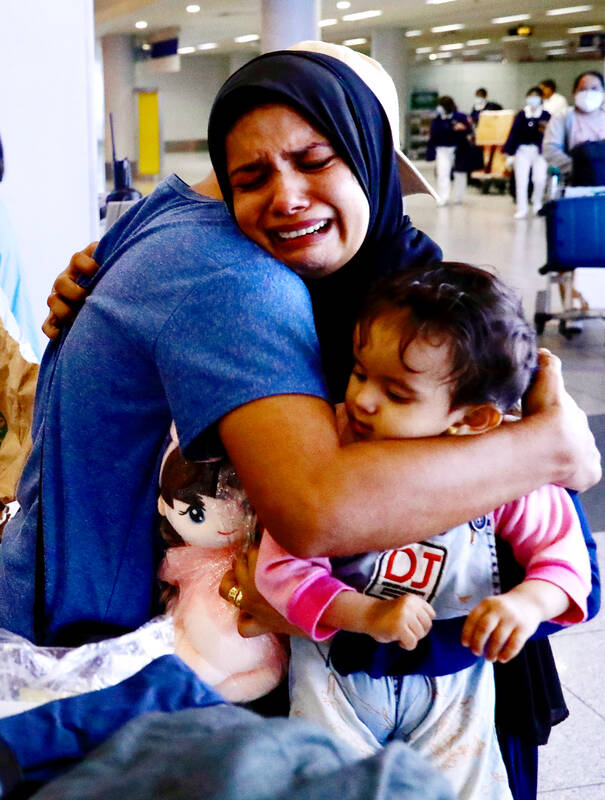Lucy Ortega thought her nightmare as an enslaved domestic worker in Syria was finally over when she boarded a government repatriation flight back to the Philippines four years ago. Instead, she faced a new set of problems.
Ortega was trafficked into servitude for eight years in Syria, then stranded for two years with other maids in a shelter in the Philippine Embassy when she sought help — an episode that caused outrage in the Philippines and made global headlines.
But since arriving home, she has received no government compensation for the embassy ordeal, trauma counselling or help finding work. Now 43 and with three young children, job offers are increasingly scarce, she said.

Photo: EPA-EFE
“I was enticed to work abroad because there were no good jobs in the Philippines. But since coming back, it’s become harder for me to find work,” Ortega said in her small wooden home in a shantytown in the capital, Manila.
The Philippines is among the world’s top sources of migrant labour and Filipino workers overseas sent back an estimated $40 billion in remittances to their families last year, accounting for about 10 percent of gross domestic product (GDP).
The government covers emergency repatriation costs for workers caught up in wars, political crises or exploitation abroad.
During the COVID-19 pandemic, 2.24 million Filipinos were flown home free of charge, and dozens of Filipino women and their children have recently been repatriated temporarily from Gaza and Israel due to the war between Israel and Hamas.
‘WEAKEST LINK’
But with the number of Filipinos who received overseas employment certificates at a record high of about 2.5 million in 2023, migrant rights advocates are sounding the alarm about the problems faced by many returnees on arriving home — from unemployment to homelessness.
“The latest government figures mean we are sending 6,800 Filipinos per day (abroad). More and more Filipinos can be at risk, especially in conflict areas, if we fail to properly monitor all of them,” said Arman Hernando, chairperson of migrant rights group Migrante Philippines.
“Are we deploying more Filipinos than we can protect?” he asked.
Some say more must be done to support them by the country’s Department of Migrant Workers (DMW), a government agency established two years ago to facilitate overseas employment and reintegration services for returning Filipinos.
Reintegration is “the weakest link” in the country’s migration policies, according to a 2023 study by a group of university researchers on economic migrants.
Seeking to address such concerns, the DMW launched a command centre in 2022 to provide rapid repatriation and welfare assistance to distressed migrant workers.
The problem, said Hernando, is that the agency only offers emergency assistance and not a comprehensive reintegration plan, which should include jobs, housing aid as well as legal advice and mental health care services.
Such an approach would also encourage the country’s migrant labour force to come home, helping to build national industry and sustain the economy’s long-term growth, economic analysts say.
The DMW and the Department of Foreign Affairs, the two agencies in charge of repatriation, did not respond to requests for comments.
NO JOB, NO HOME
Filipinos repatriated from Syria and recent returnees from Gaza said the government had paid for their flights and provided an emergency cash assistance of between 10,000 and 50,000 Philippine pesos (US$178-$889).
Some of them were encouraged to use the money to start a small business.
But after spending sometimes years abroad, many migrant workers lack the social network required to launch a successful enterprise, said Hernando.
Few migrant workers have a background in self-employment, according to a survey published by the UN migration agency in 2022. It showed finding a way to make a living was rated as the biggest challenge by more than 80 percent of Filipino returnees.
Ortega, who leads a support group of 52 trafficked domestic workers repatriated from Syria, said they had received just 10,000 pesos from the government and no other reintegration services since returning to the Philippines.
She is now working part-time in a lottery outlet, earning less than the minimum wage.
“I need a stable job for my three children who are still in school,” she said, adding that she also wanted government help to retrieve unpaid wages from her employer in Syria and redress over the conduct of embassy staff when she was marooned there.
“I need justice, but I also need money,” she said.
Maria Eliza Alcala, 47, another trafficked domestic worker who returned home from Syria in 2020, said it was especially hard for middle-aged mothers like her to find a job due to age discrimination.
“No one would hire me,” said Alcala, who cares for her 85-year-old mother with Alzheimer’s in exchange for free lodging from her brother.
Housing and emergency accommodation is another major headache, repatriated migrants said.
Dozens of the women who left Gaza recently ended up sharing a university dormitory with students after a local NGO heard they had nowhere else to stay.
“Authorities told us to return to our local government units ... but they don’t know who we are, and there was nothing waiting for us there,” said one of the women, asking not to be named.
Despite the risks, some of the returnees from Syria travelled abroad for work again after losing hope of finding work at home — especially during the pandemic when unemployment rose to 10.3 percent, Alcala said.
Migrating to work overseas is always a gamble, said Hernando, but the lack of sufficient support at home pushes some to take the risk.
“Sometimes you win, sometimes you lose,” he said. “(But) many of them leave again despite suffering abuses abroad because there’s no real reintegration here.”

That US assistance was a model for Taiwan’s spectacular development success was early recognized by policymakers and analysts. In a report to the US Congress for the fiscal year 1962, former President John F. Kennedy noted Taiwan’s “rapid economic growth,” was “producing a substantial net gain in living.” Kennedy had a stake in Taiwan’s achievements and the US’ official development assistance (ODA) in general: In September 1961, his entreaty to make the 1960s a “decade of development,” and an accompanying proposal for dedicated legislation to this end, had been formalized by congressional passage of the Foreign Assistance Act. Two

March 31 to April 6 On May 13, 1950, National Taiwan University Hospital otolaryngologist Su You-peng (蘇友鵬) was summoned to the director’s office. He thought someone had complained about him practicing the violin at night, but when he entered the room, he knew something was terribly wrong. He saw several burly men who appeared to be government secret agents, and three other resident doctors: internist Hsu Chiang (許強), dermatologist Hu Pao-chen (胡寶珍) and ophthalmologist Hu Hsin-lin (胡鑫麟). They were handcuffed, herded onto two jeeps and taken to the Secrecy Bureau (保密局) for questioning. Su was still in his doctor’s robes at

Last week the Democratic Progressive Party (DPP) said that the budget cuts voted for by the China-aligned parties in the legislature, are intended to force the DPP to hike electricity rates. The public would then blame it for the rate hike. It’s fairly clear that the first part of that is correct. Slashing the budget of state-run Taiwan Power Co (Taipower, 台電) is a move intended to cause discontent with the DPP when electricity rates go up. Taipower’s debt, NT$422.9 billion (US$12.78 billion), is one of the numerous permanent crises created by the nation’s construction-industrial state and the developmentalist mentality it

Experts say that the devastating earthquake in Myanmar on Friday was likely the strongest to hit the country in decades, with disaster modeling suggesting thousands could be dead. Automatic assessments from the US Geological Survey (USGS) said the shallow 7.7-magnitude quake northwest of the central Myanmar city of Sagaing triggered a red alert for shaking-related fatalities and economic losses. “High casualties and extensive damage are probable and the disaster is likely widespread,” it said, locating the epicentre near the central Myanmar city of Mandalay, home to more than a million people. Myanmar’s ruling junta said on Saturday morning that the number killed had